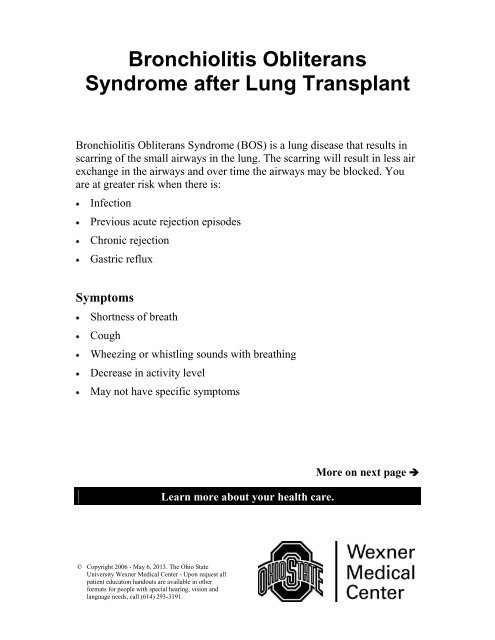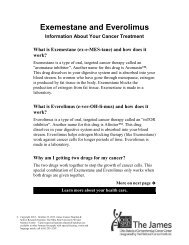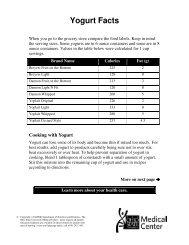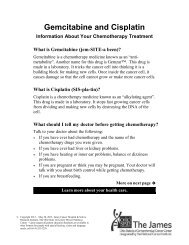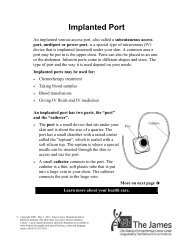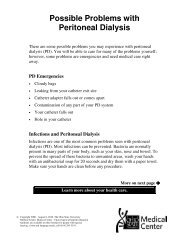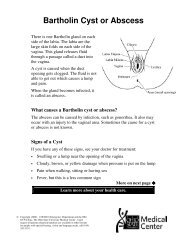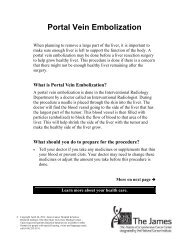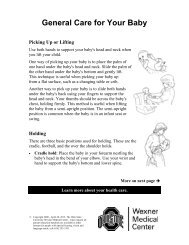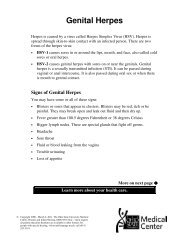Bronchiolitis Obliterans - Patient Education Home - Ohio State ...
Bronchiolitis Obliterans - Patient Education Home - Ohio State ...
Bronchiolitis Obliterans - Patient Education Home - Ohio State ...
Create successful ePaper yourself
Turn your PDF publications into a flip-book with our unique Google optimized e-Paper software.
<strong>Bronchiolitis</strong> <strong>Obliterans</strong><br />
Syndrome after Lung Transplant<br />
<strong>Bronchiolitis</strong> <strong>Obliterans</strong> Syndrome (BOS) is a lung disease that results in<br />
scarring of the small airways in the lung. The scarring will result in less air<br />
exchange in the airways and over time the airways may be blocked. You<br />
are at greater risk when there is:<br />
Infection<br />
Previous acute rejection episodes<br />
Chronic rejection<br />
Gastric reflux<br />
Symptoms<br />
Shortness of breath<br />
Cough<br />
Wheezing or whistling sounds with breathing<br />
Decrease in activity level<br />
May not have specific symptoms<br />
Learn more about your health care.<br />
More on next page <br />
© Copyright 2006 - May 6, 2013. The <strong>Ohio</strong> <strong>State</strong><br />
University Wexner Medical Center - Upon request all<br />
patient education handouts are available in other<br />
formats for people with special hearing, vision and<br />
language needs, call (614) 293-3191.
Page 2<br />
Testing<br />
After a physical exam, you may have tests to find out the cause of your<br />
problem. These tests may include:<br />
Pulmonary Function Test (PFT): PFT is done to check the function of<br />
your lungs. The test measures both the amount of air you move in and<br />
out of your lungs and how easy it is for you to breathe. Read the<br />
handout Pulmonary Function Testing for more information.<br />
Bronchoscopy and Biopsy: A long tube called a bronchoscope is put<br />
into your nose or mouth and passed down through your trachea<br />
(windpipe) into your lungs. The tip of the scope has a light and camera<br />
that lets the doctor see your lungs and airways. During the test, a tissue<br />
sample may be taken for laboratory testing (biopsy). Read the handout<br />
on Bronchoscopy for more information.<br />
Chest CT: This is an x-ray scan using a special x-ray machine and<br />
computer. The scan creates thin slices or segments of the test. Read the<br />
handout on Chest CT for more information.<br />
Treatment<br />
Treatment slows the progression of the disease, but it is not a cure.<br />
Depending on the cause, treatment works to:<br />
Prevent respiratory infections.<br />
Prevent acute rejection.<br />
Control chronic rejection with medicine.<br />
Support lung function through Pulmonary Rehabilitation. If you are not<br />
enrolled in therapy, our team will connect you with a therapist.<br />
If you have any questions or concerns, talk with your transplant<br />
coordinator, nurse or doctor.<br />
Talk to your doctor or others on your health care team if you have<br />
questions. You may request more written information from the<br />
Library for Health Information at (614) 293-3707 or email:<br />
health-info@osu.edu.


